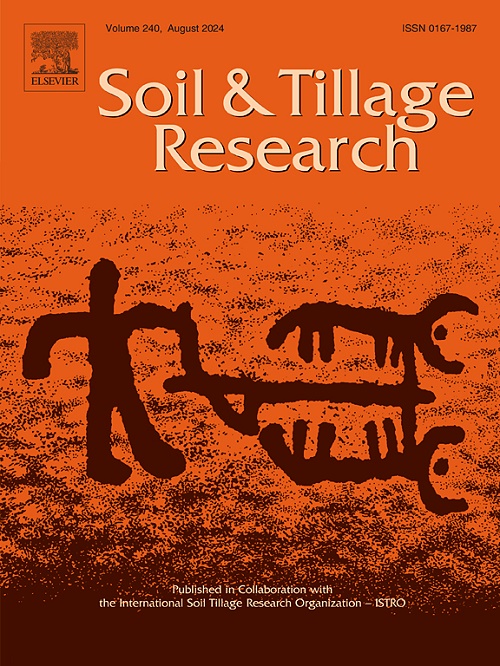Deep banding of controlled-release potassium chloride increases soybean productivity by regulating microbial communities and improving potassium uptake
IF 6.1
1区 农林科学
Q1 SOIL SCIENCE
引用次数: 0
Abstract
While deep banding fertilization and controlled-release potassium chloride (CRK) application improve crop yields by optimizing potassium (K) spatial distribution and reducing its fixation by 2:1 clay minerals, there is still limited information on K fertilization strategies suitable for sustainable soybean production. In this study, a two-year field experiment was conducted to investigate how soybean growth, soil microbial communities, and K availability are affected by different fertilization methods (broadcast incorporation versus deep banding) and K fertilizer types (conventional potassium chloride (KCl) versus CRK). The results showed that deep banding led to 3.4 %–4.1 % and 3.3 %–4.5 % higher soybean yield and 3.0–5.7 and 2.7–6.9 percentage points higher K use efficiency (KUE) than broadcast incorporation in 2023 and 2024, respectively. Compared to conventional KCl, CRK significantly improved soybean yield and KUE by 7.4 %–8.1 % and 10.9–11.9 percentage points in 2023, and 9.7 %–11.0 % and 8.9–13.1 percentage points in 2024, respectively. Meanwhile, CRK promoted soil microbial diversity, soil K availability, and soybean physiological traits. Of all treatments, deep banding of CRK resulted in the highest microbial diversity and relative abundances of beneficial microorganisms such as Lysobacter and Sphingomonas, thereby promoting nutrient cycling, increasing soybean antioxidant enzyme activities and endogenous hormone contents, and ultimately improving soybean productivity. In conclusion, deep banding of CRK can significantly improve soybean yield and KUE. This study provides an important scientific basis for the management and optimization of K fertilization in soybean production in China.
控释氯化钾深施通过调控微生物群落和促进钾吸收来提高大豆产量
虽然深带肥和控释氯化钾(CRK)通过优化钾(K)的空间分布和减少2:1粘土矿物对其的固定来提高作物产量,但适用于大豆可持续生产的钾施肥策略的信息仍然有限。本研究通过为期两年的田间试验,研究了不同施肥方式(撒播肥与深带肥)和钾肥类型(传统氯化钾与CRK)对大豆生长、土壤微生物群落和钾有效性的影响。结果表明,在2023年和2024年,与撒播相比,深条带可使大豆产量提高3.4 % ~ 4.1 %和3.3 % ~ 4.5 %,钾肥利用效率分别提高3.0 ~ 5.7和2.7 ~ 6.9个百分点。与常规KCl相比,CRK显著提高了2023年大豆产量和KUE,分别提高了7.4 % ~ 8.1 %和10.9 ~ 11.9个百分点,2024年分别提高了9.7 % ~ 11.0 %和8.9 ~ 13.1个百分点。同时,CRK对土壤微生物多样性、土壤钾有效性和大豆生理性状有促进作用。在所有处理中,CRK深带处理导致溶菌和鞘氨单胞菌等有益微生物的多样性和相对丰度最高,从而促进养分循环,提高大豆抗氧化酶活性和内源激素含量,最终提高大豆产量。综上所述,深施CRK可显著提高大豆产量和KUE。本研究为中国大豆生产中钾肥的管理和优化提供了重要的科学依据。
本文章由计算机程序翻译,如有差异,请以英文原文为准。
求助全文
约1分钟内获得全文
求助全文
来源期刊

Soil & Tillage Research
农林科学-土壤科学
CiteScore
13.00
自引率
6.20%
发文量
266
审稿时长
5 months
期刊介绍:
Soil & Tillage Research examines the physical, chemical and biological changes in the soil caused by tillage and field traffic. Manuscripts will be considered on aspects of soil science, physics, technology, mechanization and applied engineering for a sustainable balance among productivity, environmental quality and profitability. The following are examples of suitable topics within the scope of the journal of Soil and Tillage Research:
The agricultural and biosystems engineering associated with tillage (including no-tillage, reduced-tillage and direct drilling), irrigation and drainage, crops and crop rotations, fertilization, rehabilitation of mine spoils and processes used to modify soils. Soil change effects on establishment and yield of crops, growth of plants and roots, structure and erosion of soil, cycling of carbon and nutrients, greenhouse gas emissions, leaching, runoff and other processes that affect environmental quality. Characterization or modeling of tillage and field traffic responses, soil, climate, or topographic effects, soil deformation processes, tillage tools, traction devices, energy requirements, economics, surface and subsurface water quality effects, tillage effects on weed, pest and disease control, and their interactions.
 求助内容:
求助内容: 应助结果提醒方式:
应助结果提醒方式:


